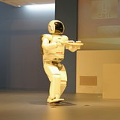This paper presents Particle-based Object Manipulation (Prompt), a new approach to robot manipulation of novel objects ab initio, without prior object models or pre-training on a large object data set. The key element of Prompt is a particle-based object representation, in which each particle represents a point in the object, the local geometric, physical, and other features of the point, and also its relation with other particles. Like the model-based analytic approaches to manipulation, the particle representation enables the robot to reason about the object's geometry and dynamics in order to choose suitable manipulation actions. Like the data-driven approaches, the particle representation is learned online in real-time from visual sensor input, specifically, multi-view RGB images. The particle representation thus connects visual perception with robot control. Prompt combines the benefits of both model-based reasoning and data-driven learning. We show empirically that Prompt successfully handles a variety of everyday objects, some of which are transparent. It handles various manipulation tasks, including grasping, pushing, etc,. Our experiments also show that Prompt outperforms a state-of-the-art data-driven grasping method on the daily objects, even though it does not use any offline training data.
翻译:本文展示了基于粒子的物体操纵( Prompt), 这是在没有先前的物体模型或大型天体数据集预培训的情况下, 以机器人操作新对象的新方法 。 快速的关键元素是一个基于粒子的物体表达方式, 每个粒子代表着天体中的某个点、 该点的局部几何、 物理和其他特征, 以及它与其他粒子的关系 。 像基于模型的分析操作方法一样, 粒子表达方式使机器人能够对天体的几何和动态进行解释, 以便选择合适的操作动作 。 像数据驱动方法一样, 粒子代表方式是实时从视觉传感器输入中, 特别是多视图 RGB 图像中学习 。 粒子表达方式因此将视觉感知与机器人控制联系起来 。 快速地将基于模型的推理和数据驱动学习的好处结合起来。 我们从经验上证明“ 提示” 成功处理各种日常物体, 有些是透明的。 它处理各种操纵任务, 包括捕捉、 推推等。 我们的实验还显示, 甚至在直射超越天体的物体上显示, 尽管掌握了任何数据驱动方法。


